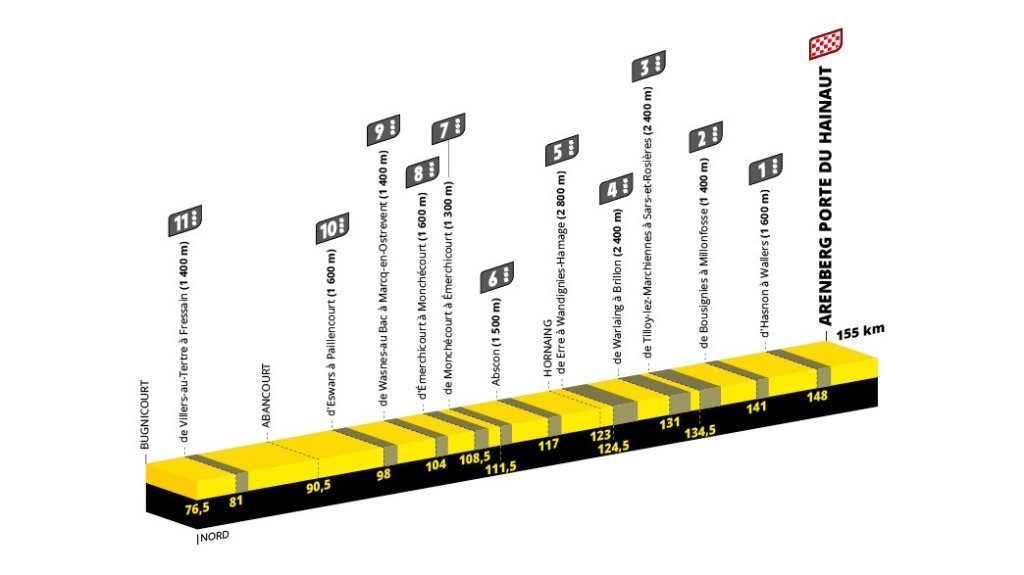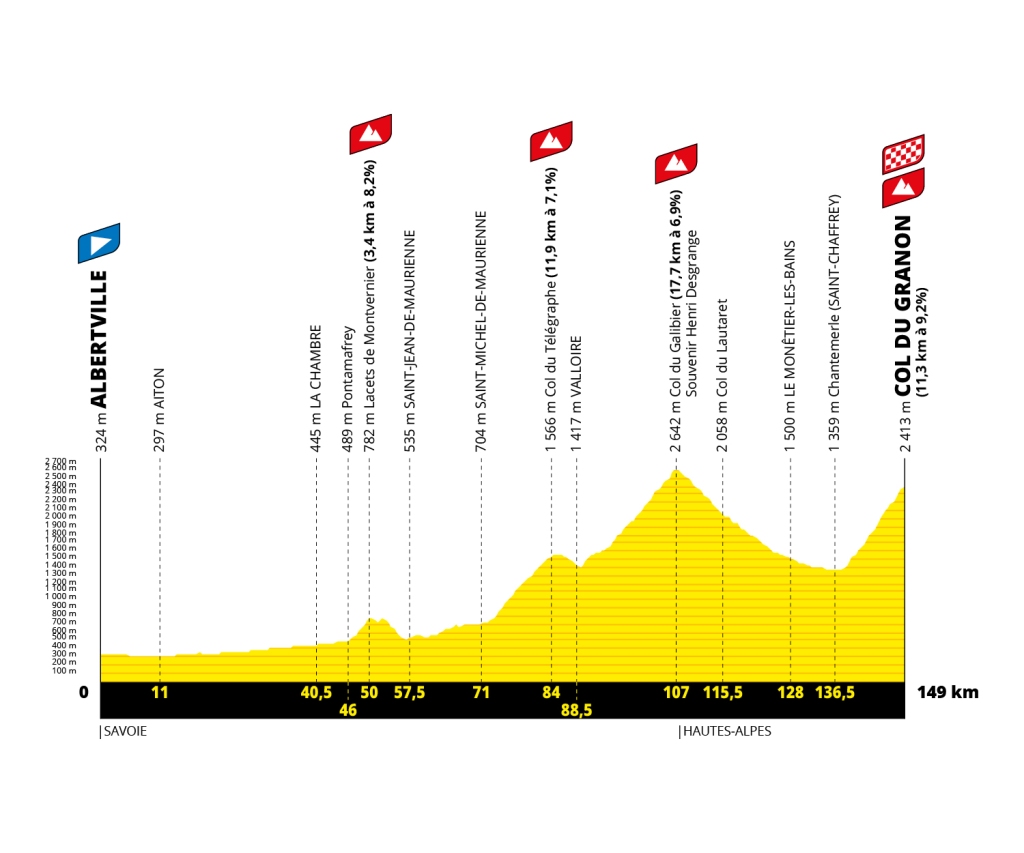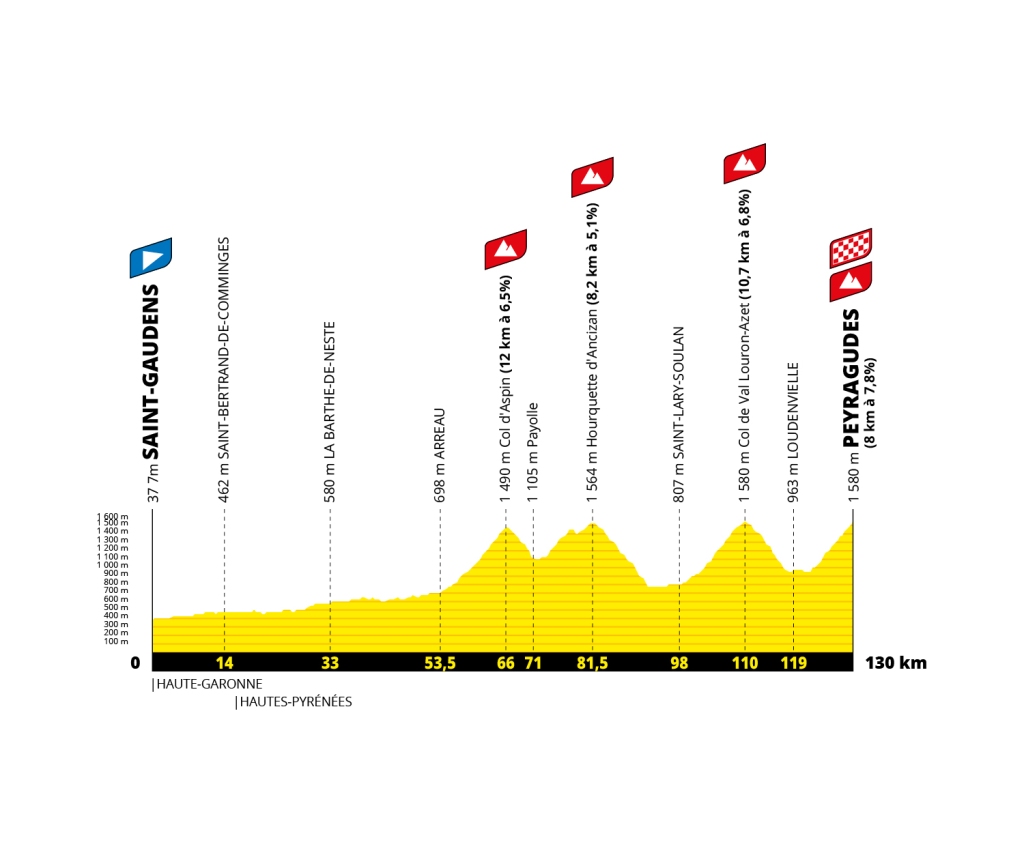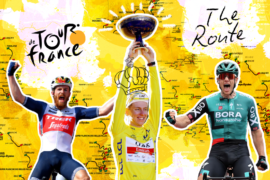2022 Tour De France: Stage by Stage with Paul Andrew
Twenty-one stages across four countries. Sky-high bridges, cantankerous cobbles, and mythical mountains. It is, and could only be, the 2022 Tour de France. The race that dominates all others, the event synonymous with professional cycling. We got our man on tour: Paul Andrew to walk you through his own monumental task to conquer the course stage by stage.
Words by our ambassador Paul Andrew
I have tried to ride half of the 2022 Tour de France for the last two years. Unfortunately, these have been canceled, despite having completed lots of painful training. 2022 is the year and I’m all in, going for the full tour with all the adventure, excitement, experiences, and pain that will bring. Le Loop follows the official route of the 2022 Tour de France, one week ahead of the professionals, and finishes 21 stages later in Paris, some 3,400kms later on Sunday 17th July. On Friday 24th June 2022 around 100 riders will gather in Copenhagen for the ‘Grand Depart’.
Stage 1: Copenhagen – Copenhagen. 13km. Fri 24th Jun
A leisurely start to his adventure, this short stage of the 2022 Tour de France takes in some of the sights and scenery of what is arguably the world’s foremost cycling city. For the pros this will be a fast inner-city time trial, on closed roads with no obstacles – for them it’ll be a chance to warm our legs up, and enjoy the rare experience of an urban environment where the cyclist is king. He’ll join the 40,000 Danes who cross the Queen Louise Bridge every day (it’s the world’s busiest cycle path), admire Eriksen’s Little Mermaid statue, and he’ll roll past Tivoli Gardens: the world’s second-oldest amusement park.
With no route profile to speak of, it’s unlikely he’ll even need to change gear on today’s stage, and there’ll be plenty of time to recover from their paltry exertions and seek out some of Copenhagen’s famous pastries as fuel for the days ahead.

Stage 2: Roskilde – Nyborg. 199km. Sat 25th Jun
Today’s stage is all about wind – as plotted by 2022 Tour de France Director Christian Prudhomme, who has described the three prologue stages as “a compendium of bicycle racing on flat terrain.” he’ll set off from ancient Roskilde, and visit the Viking capital of Lejre (home of world champ Mads Pedersen) before turning back to the coast for a couple of hours’ riding through quiet seaside towns, and alongside the fjords of Inderbredning, Holbæk, and Lammefjord. Then they will tackle three of Denmark’s steepest hills in quick succession, though their respective gradients (5.8%, 4.7%, 5.6%) shouldn’t give them too much trouble – as many Danish cyclists will tell you, “the headwinds are our mountains.”
For now, they have side winds to contend with, along an open stretch of coastline between Kalundborg and Korsør, where low-lying farmland offers expansive views (but little shelter!), and they will give thanks for the quiet country roads and smooth tarmac. Unlike the Tour, they won’t be allowed to cycle over the 18km Storebælt Bridge between Zealand and Funen, which may be a relief, as the pros are predicted to face a strong head-sidewind here. Their day’s riding will end just before the water, and they will get to enjoy the bridge from the relative comfort of our transfer coach the following morning.

Stage 3: Vejle – Sønderborg. 182km. Sun 26th Jun
This is a flat stage by Tour standards, but still offers more climbing than you might have been expecting in Denmark. The first couple of hours take them through Vejle’s hilly hinterland to Jelling, and past the ancient runic stone known as ‘Denmark’s birth certificate’. From there’s it’s south through lush green countryside to Kolding, where they will admire the town’s imposing 13th-century castle, and briefly skirt the coast (and pause for ice cream?) before warming their legs up via the steady (though uncategorised) hill between Binderup and Grønninghoved.
There’s a short categorised climb out of Hejlsminde, and cobbled streets to look forward to as they pass through the UNESCO heritage site of Christiansfeld, famous for beautifully preserved 18th-century architecture and cyclist-friendly honey cakes!
The approach to Aabenraa takes them up onto the Knivsbjerg ridge, and through the ancient berry-filled woodland of Jørgensgård, as they move into the rolling Danish-German borderlands – famous internationally for having been drawn according to a public vote. The iconic Dybbøl windmill welcomes them to Sønderborg, and they will enjoy a flat loop of the picturesque town to finish.

Rest Day 1: Mon 27th Jun
Today will be a transfer day.
Stage 4: Dunkerque – Calais. 172km. Tues 28th June
The north coast of France is not known for its mountains, but this is a surprisingly punchy little stage, with some stiff climbs spaced out over the day’s ride. The stage has been cleverly designed and will be a treat to cycle: quiet, rural roads, plenty of views, and lots of small villages will give it a very French feel. From the famous port of Dunkirk, they head south inland, across quiet farmland, through forests and wetlands, and then back up towards the Opal Coast, where (hopefully) westerly winds will blow them along the English Channel towards our destination of Calais. The views are magnificent along this last coastal stretch of the day; ample reward for their first hundred milers in France!
Stage 5: Lille Métropole – Arenberg Porte du Hainault: 155km. Wed 29th Jun
It’s back to their old friends, the cobbles – except that this year they are treated to a few sectors never seen before in the 2022 Tour de France, or even Paris-Roubaix. (The route stops short of the notorious Arenberg Trench). All together they will ride 19.4km of bone-shaking farm roads, over 11 different sectors, with the longest coming in the second half of the day when arms and legs are beginning to tire. However, alongside the bravado of riding the cobbles, the majority of their day’s ride will be on comfy Flemish tarmac, with relatively little elevation gain, and a chance to admire the wheat fields and rural red-brick villages of this French cycling heartland, tucked in next to the Belgian border.

Stage 6. Binche – Longwy. 220km. Thurs 30th June
Today takes them on a beautiful journey from Belgium to France and the landscape evolves over the course of the ride, from the low-lying farmlands of central Belgium to the dense forests and steep hills of the Franco-Belgian borderlands. There are no cols here, but over 220km (20km longer than any other stage on this year’s Tour) they will still be covering a significant amount of climbing, and the final haul up to the old stone citadel at Longwy will be brief but brutal, with sections of 12% and 11% in the final kilometres, which will challenge the puncheurs of the pro peloton, and ensure that they go to bed with an enhanced appreciation for the uncompromising landscapes (and beer and chips) of one of European cycling’s most hallowed regions.
Stage 7: Tomblaine – Super Planche des Belles Filles. 172km. Fri 1st July
The first official mountain stage of the 2022 Tour de France finishes at the increasingly iconic Super Planche des Belles Filles, where Pogačar snatched victory from Roglič in 2020 – but the road to get there will ensure that you don’t just remember stage 7 for its final climb. The stage is far from flat, gradually climbing from the first feed stop for almost 50km to top 900m just over halfway through. They pass through the countryside of Alsace-Lorraine, admiring yet another side of France’s diverse heritage in the distinctive Germanic architecture of this region’s towns and villages. Then follows the beautiful Vosges, a “secret” corner of France which isn’t well enough known but it’s a cyclist’s dream; shady switchbacks up forested hillsides, quiet, perfect tarmac. And then… the final spectacular kilometres – the last being gravel, and a brief 24% wall – to see where the men’s Tour will fight their first mountain battle a week hence, and the very first winner of the Tour de France Femmes will be crowned at end of the month.
Stage 8. Dôle – Lausanne. 184km. Sat 2nd July
They will cross yet another border during today’s ride, as the 2022 Tour de France makes a rare excursion to Switzerland. This will be one of those blissful stages where the mountains are visible, but the climbing is relatively low in gradient and altitude, as they follow valleys and low-lying hills through the Jura Massif, up to a manageable 1100m – think forested slopes, brilliant green meadows, and mighty limestone crags, towering over them as we wind our way east. After the day’s ups come to the downs, and they have an easy finale, descending to the lowlands and winding through picture-perfect Swiss countryside to end the day in Lausanne, hopefully with a view of the Alps across Lake Geneva.
Stage 9: Aigle – Châtel. 183km. Sun 3rd July
This stage offers them the treat of exploring an area rarely visited by the Tour caravan and comes in at over 3600m of climbing… They will set off from Aigle – home of the UCI and some excellent vineyards – and spend the morning gaining height gradually, among the modest green peaks of the Gruyère region (yes, of course, there will be cheese at the feed stops), and then the real elevation gain will start midway through the stage, as they depart Rossiniere, home to the Grand Chalet, Switzerland’s largest inhabited wooden house! The first climb, Col des Mosses, is an hour or so uphill at a relatively sedate 4.1% gradient, but it’s closely followed by Col de la Croix (almost twice as steep, and our high point of the ride so far), and then, after a long descent back towards Aigle, they will climb the switchbacks of Pas de Morgins, overlooked by fairytale mountain peaks, to re-enter France, and finish a few kilometres later, after a brief descent, and a small final climb to Châtel, to end their day on a high.

Rest Day 2: Mon 4th July
Relax …
Stage 10: Morzine – Megève. 148km. 5th July.
Although today’s stage finishes at 1,460m and is entirely within the most mountainous ‘Haute Savoie’ department of France (think cowbells, wooden chalets dotting the hillsides, plenty of cheese, and quiet, winding mountain roads), it is actually classified as ‘hilly’ rather than mountainous so you can treat this stage as a warm-up for the two stages ahead. They leave their rest day hotel in Morzine and roll gradually downhill along the steep-sided Dranse Valley until it opens out and they are treated to a scenic few kilometres along the blue expanse of Lake Geneva. Heading south, back into the mountains up the neighbouring valley, they will gaze up at the magnificent crags, and finish our day with the sensible gradients of the ascent to Megève – a lot of bangs, for relatively little buck.
Stage 11. Albertville – Col du Granon. 149km. 6th July
Today is the first of two back-to-back monster mountain stages and is packed with classic cols and over 4,000m of climbing. They are to set out from Tour favourite Albertville, and warm up with a roll along the Maurienne Valley, before tackling the Lacets de Montvernier – a short sharp climb up a near-vertical cliff face, with switchbacks so tightly packed they look like something out of a cartoon. Legs well-and-truly awakened, they will then progress along the valley towards the Col du Télégraphe, a 12km uphill slog (with switchbacks aplenty), which serves as an appetiser for the mightly Galibier, which we’ll meet after only a short descent via Valloire. The gradient here is marginally gentler, but as we will be venturing above 2,500m, the altitude will easily cancel that out. After recovering legs and lungs over an hour or so’s descent, we will then finish them off for the day by riding up the Col du Granon – known and feared for its unrelenting steepness – before heading down to Briançon for a well-earned rest

Stage 12. Briançon – Alpe d’Huez. 166km. 7th July
This stage has it all – magnificent scenery, four big-name cols, and a nod to the Tour’s rich history (it’s an exact replica of the 1986 stage where Bernard Hinault and Greg Lemond crossed the finish line arm in arm). From Briançon they will double back on ourselves, retracing our path to enjoy the views from the other direction as they cycle back up the Galibier (quite a special thing to do the morning after you first summited). Then down to Valloire, back over the Col du Télégraphe, and along the valley to Saint-Jean-de-Maurienne. From there we’ll face a 29km ascent of the Col de la Croix de Fer. This formidable climb is most challenging in the lower sections, with several kilometres at just under 10%, but once they are past the Sallanches Viaduct it calms down to a relatively manageable tilt for the next 8km, before ramping up again towards the top. The descent from Croix de Fer is long and luscious, with a pretty turquoise Alpine lake en route, and a couple of small uphills to keep your legs awake. And then, after a spin along the pan-flat Romanche Valley, comes the grand finale – the legendary 21 hairpins of Alpe d’Huez, where we will spy the names of our heroes etched on the road, pass the international legions of fans already setting up camp for the following week, and reflect on a ride that will have stretched each of them their limit.

Stage 13. Bourg d’Oisans – Saint-Étienne. 193km. 8th July
This delightful stage packs a surprising variety of scenery into a single day’s riding and will leave them with the sense of having traveled much further than 200km since breakfast. They will bid a fond farewell to the Alpine peaks, and roll westwards, through verdant farmland, towards the splendid city of Grenoble, overlooked by the distinctive cliffs of the Vercors and Chartreuse ranges.
The quiet, leafy Col de Parmenie offers one of only two real uphill challenges of the day as they leave the crags behind us, and pass through the vineyards of the fertile Rhône Valley. As they cross the river itself, they know that they have left the Alps behind and can start to look forward to the rugged and remote landscape of central France. Their day ends in Saint-Étienne, a friendly former mining city, on the fringe of the Massif Central where the route rudely zips up into the punchy hills north of town, providing a sting in the tail of a stage that will surprise with its beauty.
Stage 14: Saint-Étienne – Mende. 195km. 9th July.
After a night in Saint-Étienne they will set out across the hilly countryside that is unfamiliar to many – expect high plateaux, deep river valleys, and that far-away-from-everything feeling as they traverse one of France’s most enigmatic and thinly populated regions. They will pass through the pilgrimage city of Puy-en-Velay – famous for lentils, and its stunning 12th-century cathedral, pacing ourselves for a long and hilly stage that amply delivers on views. As they continue west, there’ll be a brief respite from the climbing as they cycle through a truly spectacular canyon and they will need to rely on the chat and camaraderie of the peloton to see us through the rolling roads that follow – there is little about this region that is flat. The stage concludes with the infamous Montée de la Croix Neuve, also known as the Montee Jalabert, a super-stiff 3km climb up to the aerodrome at Mende, which is just what you tired legs will not be needing at that point.
Stage 15. Rodez – Carcassonne. 200km. Sun 10th July
A day of classic Tour de France scenery, as they spin along plane-tree-lined avenues and past fields of endless sunflowers. Christian Prudhomme promised that this stage has been designed to suit the sprinters’ teams – i.e. it should be perfectly flat (in Tour terms, that means undulations that won’t total much more than 1500m of ascent). But no Tour stage is without its trials and after lunch, we gain 500m quite quickly in what will definitely feel like a climb, making their way through the hills of Haut-Languedoc and up onto a plateau with views stretching far and wide. This stage should be a relaxed affair, and you can expect a summer holiday feel as they cruise through the beautiful countryside towards Carcassonne, where Mark Cavendish won his 34th stage in 2021, finally equalling the record of Eddy Merckx. Carcassonne itself is a medieval walled town, complete with ramparts, moat, and drawbridge (although they will be staying in the new town to the west) – it’s a great place for some rest day sightseeing!
Rest Day 3: Carcassonne. Mon 11th July
Time to sightsee, wash clothes, eat lots and clean their bike!
Stage 16. Carcassonne – Foix. 179km/140km. 3150m/2600m ascent. 12th July
It’s another day of changing scenery at the 2022 Tour de France, as we roll southwards out of Carcassonne, through vineyards and fields of sunflowers, watching big green mountains draw closer and closer on the horizon, as they finally reach the Pyrenees. There are a couple of smaller categorised climbs earlier in the day, but the real fun begins when they set off up the Port de Lers, just over halfway through. This is a steady climb (nothing scarily steep, but you’ll definitely be glad once you’re at the top) with a quiet road winding up to windswept pastureland, well above the tree line – you’re already a world away from the sunflowers. Then it’s down to the quirky little town of Massat, and on to today’s showstopper: the Mur de Péguère. This one actually is scarily steep, with sections of 16% and 18%, but it’s also a quiet road, with minimal traffic (they don’t normally let fans line the roadsides here), and the descent to Foix that follows is a fun one.

Stage 17. Saint-Gaudens – Peyragudes. 130km/110km. 3300m/2400m ascent. 13th July
This 2022 Tour de France stage packs an impressive 3,300m of climbing into a relatively short ride. There are four big-name climbs which follow a long run-in from Saint-Gaudens, gradually gaining height along the Garonne Valley, with its pretty stone-built villages. The mountains then close in around us as they follow the River Neste to Arreau, from where it’s a right turn up the Col d’Aspin, a well-loved Pyrenean giant with sumptuous views from its windswept summit. There’s only a brief descent before the climbing starts again, this time up the Hourquette d’Ancizan – another stunner. After a long descent down to Saint-Lary, they will tuck into our steepest climb of the day, up the vertiginous Col de Val Louron-Azet, from the top of which we’ll see our final destination across the valley: the steep ramp of the airstrip at Peyragudes. It’s another long haul to get up there, but before that, they get to enjoy descending the tightly packed hairpins of Val Louron-Azet down to the breathtaking lake at Loudenvielle for a final feed stop, cool off and energy fix. Once they reach the Peyragudes ski station, they will be able to gaze back towards all the other cols they have crossed and savour our achievements.

Stage 18. Lourdes – Hautacam. 143km. 3900m ascent. Thurs 14th July.
It’s their final day in the mountains, and they go out with a bang, thanks to three massive cols, packed into the second half of the ride. After a relatively undemanding first 50km, they start the long climb out of Laruns, up the west side of the beautiful Aubisque: a taxing, but worthwhile ascent, and then dip down to follow the Cirque du Litor towards the Col du Soulor. This is one of the world’s most magnificent balcony roads, and there’s barely a kilometre of climbing to get to the next col, so you effectively get two for the price of one. After a swooping descent to Ferrières, they are then on to the Col de Spandelles. This newcomer to the Tour seems quiet and unassuming, but its remote singletrack tarmac climbs at a fairly steady 9% gradient, which will not go unnoticed by your tired legs. And then it’s the Hautacam – the final mountain of the Tour – and whether you’re sprinting or crawling to the top, you’ll want to spend some time committing the glorious Pyrenean scenery to memory, as you reflect on the privilege of being able to see these mountains through the eyes of the Tour.

Stage 19: Castelnau-Magnoac – Cahors. 189km. Fri 15th July.
Today’s ride may feel blissful to legs worn out by the mountains, but 189km is still a long way, and in this part of the world, both heat and headwinds can play their part in making a ride a struggle. However, there’s the gorgeous Occitan countryside to enjoy – the vineyards and sunflowers will be back, as will the lovely stone-and-terracotta villages of this sunny region of France. There will be minimal ups and downs as we cross the River Garonne, and head towards the limestone escarpments that overlook the River Lot, giving them plenty of time to enjoy the Dordogne scenery (as a bonus, they pass a Danish royal palace in a nod to the Grand Depart). Their stage finish today is the medieval town of Cahors, a beautiful, picture-postcard town famous for its bridges, battlements, and world-famous truffles.
Stage 20: Lacapelle-Marival – Rocamadour. 40km. Sat 16th July
This is what cycling in France should be like. The poor pros will have to go full tilt along this picturesque route, with its technical twists and turns, steep descent, and 10% climb in the final kilometres. But they can afford to take our time, admire the lush green farmland that skirts the earlier section of the route, linger in the shade of the leafy avenues as they approach the ruined Château de Saignes, and apply our brakes as they roll down into the steep-sided Alzou gorge, so as to enjoy the fairytale sight of Rocamadour’s clifftop village for just a few moments longer.

Stage 21: La Défense – Paris Champs Élysées. 100km. 17th July
Time for their lap of honour and the moment we’ve all been waiting for! Paris! But before they live out our Maillot Jaune fantasies on the sacred cobblestones of the Champs Élysées (one lap only for them– one is enough!), they will be enjoying a relatively gentle roll in from the suburbs. Mitterand’s Arche de la Defense will be our send-off and Napoleon’s Arc de Triomphe will greet us approx. 100km later (one visible from the other along the East-West axis of Paris which starts at the Louvre museum). They will stick as closely as possible to the Tour route but may have to change some portions of this 2022 Tour de France stage in order to avoid roads that can be closed for the pros but not for them.
– Paul Andrew
If you would like to find out more about Pauls’s journey click the button below.


Leave a Reply